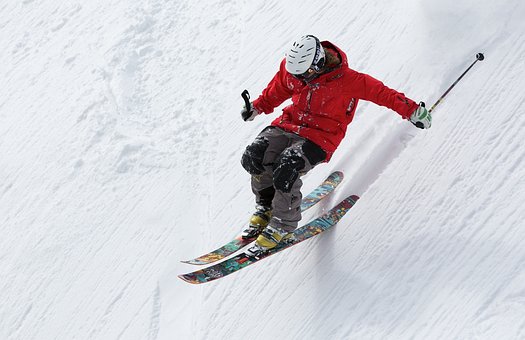 Skiing is one of those wonderful winter sports that people with drive a couple of hours to do. I tried it once but I proved to be quite unsuccessful in that I manage to go down a hill backwards. The only reason I didn't go very far was this beautiful tree I ran into butt first. I've never been again since that day. Besides its intimidating to watch a 6 year old whizzing down the advanced slope.
Skiing is one of those wonderful winter sports that people with drive a couple of hours to do. I tried it once but I proved to be quite unsuccessful in that I manage to go down a hill backwards. The only reason I didn't go very far was this beautiful tree I ran into butt first. I've never been again since that day. Besides its intimidating to watch a 6 year old whizzing down the advanced slope.The cool thing about skiing is it involves math, grades or slope, and so much more math. In skiing, they refer to slope as Piste which is French for the marked run down the mountain.
First off, slope in downhill skiing is spoke of as percent slope also known as grade. A 45 degree angle is actually a 100 percent grade. If you can visualize it in your head or draw it on graph paper, it shows up as a 1/1 slope or a rise of one foot over a run of one foot. In addition to slope, skiers must keep in mind that snow no longer sticks when the slope is over 75 degrees.
Furthermore, they must keep tract of the type of snow because the type of snow determines how fast a person can go down the hill. If the run is made of up ice, the person will ski harder than on powder snow.
In general the easiest trails have a slope between 6 and 25 percent while the next ones up are between 25 and 40 percent. Most ski resorts have the majority of the trails in this range. The more expert skiers prefer trails over 40 percent because of the challenge. The hardest trails have slopes well above 40 percent and lots of obstacles.
Now for the question of how the type of snow effects skiing. If it has not snowed in a while and people have compacted the snow by skiing repeatedly, it becomes ice. Ice is not well liked by many skiers because they cannot dig their edges into the ice and they don't have much control.
If the snow is soft, it is easily moved around by skiers and it allows them to dig their edges in so they have the most control. In addition, if they fall, they won't be hurt because the snow pads them. If the temperature gets too warm, the snow will melt during the day and refreeze during the night when temperatures drop. This means the run can be quite icy in the morning but gets slushy later on as the temperature goes up. Slushy snow lacks structure, has lots of ice, making it harder for the skier to control their run and they can get ice burns if they fall. When snow is wet, the water can create a vacuum under the skies, they don't slide easily. Its like snowing with breaks on so the skier finds it quite hard to go downhill.
So the type of skiing one experiences when going downhill depends on both the grade or slope, the type of snow, and the temperature. Imagine the types of graphs students can create from this information. They can graph the degrees of each type of slope to see how steep it is. Then they can create the grade such as 1/1 for the 45% angle to meaning to the percent. They can also create a graph based on the temperatures for the different types of snow for skiers. Finally, they can compare and contrast the classification of green, blue, and black slopes based in the United States or in Europe.
Let me know what you think, I'd love to hear. Have a great day.
No comments:
Post a Comment